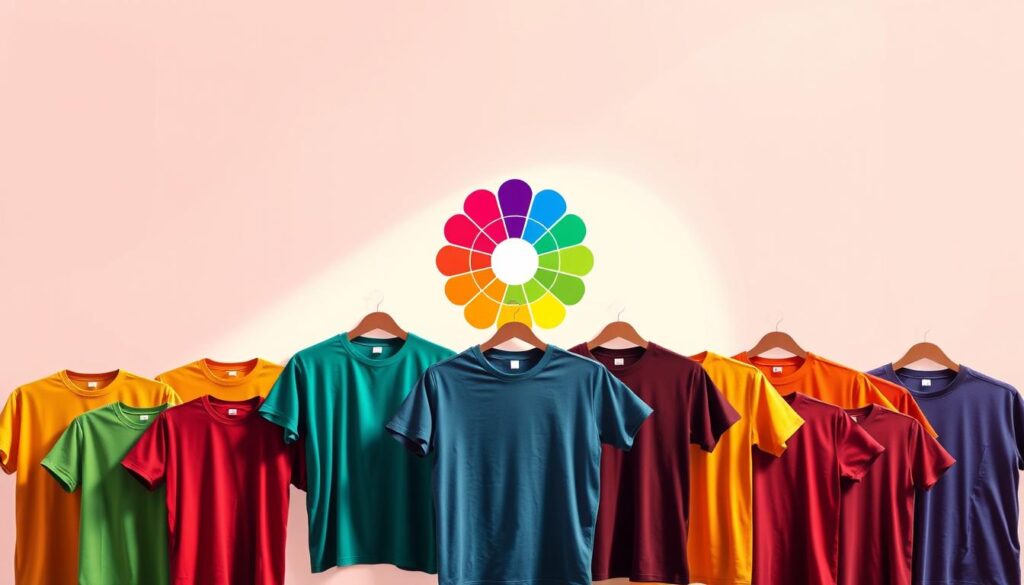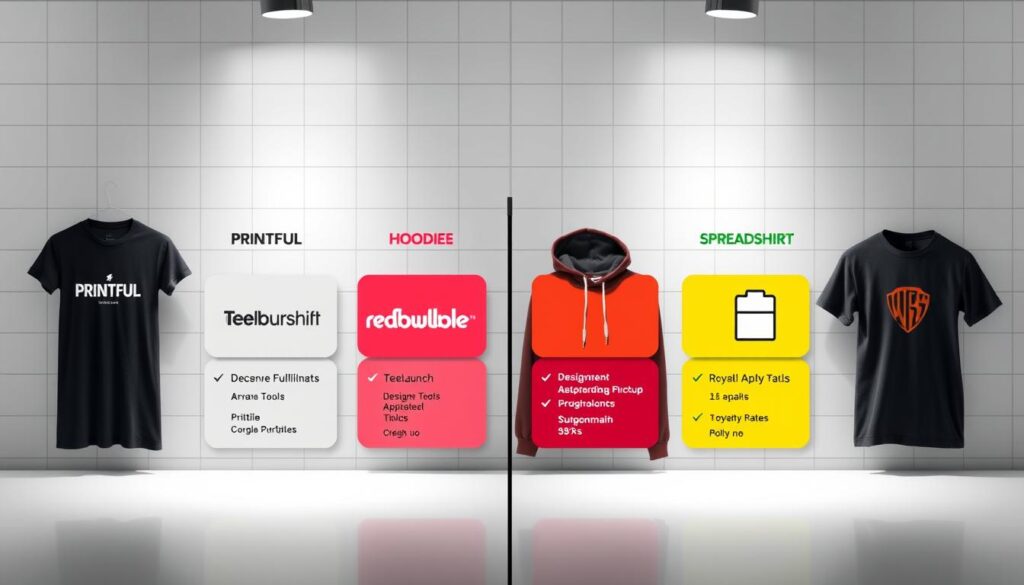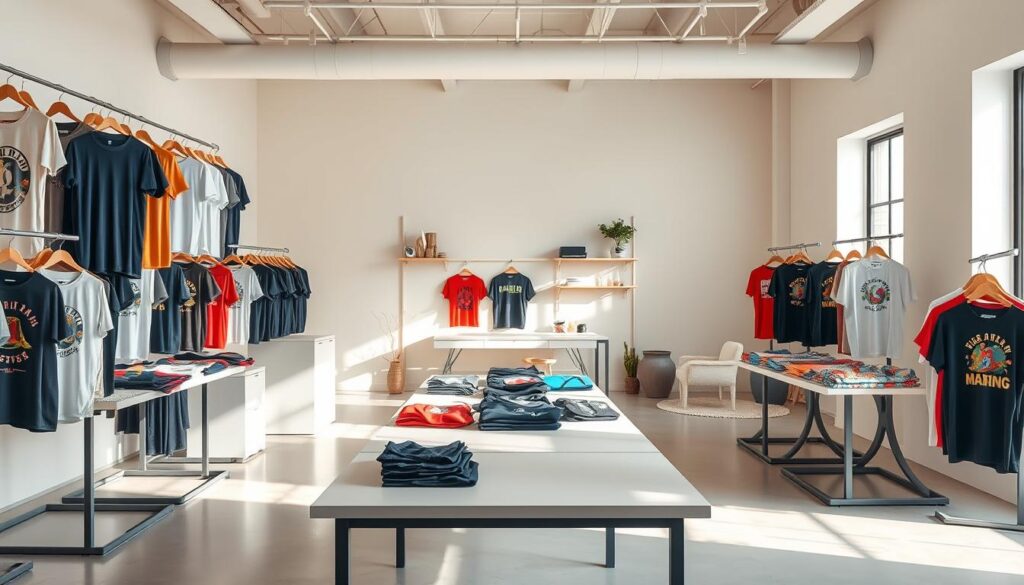Designing custom t-shirts has become a lucrative way to earn passive income. By utilizing free design tools like Canva or Photoshop, you can create unique designs that appeal to niche markets. Uploading these designs to print-on-demand (POD) platforms such as Redbubble, Teespring, or Merch by Amazon allows you to earn royalties without managing inventory or upfront costs.
The key to success lies in crafting appealing designs and using SEO-friendly titles and tags to attract organic traffic. By understanding your target audience and leveraging the right POD platforms, you can maximize your earnings.
Key Takeaways
- Use free design tools like Canva or Photoshop to create custom t-shirt designs.
- Upload your designs to POD platforms like Redbubble, Teespring, or Merch by Amazon.
- Target niche markets to increase the appeal of your designs.
- Use SEO-friendly titles and tags to attract organic traffic.
- Maximize earnings by understanding your target audience and choosing the right POD platforms.
Understanding Print-on-Demand Business Model
The print-on-demand model allows designers to create custom products without holding any inventory. This innovative approach has transformed the way entrepreneurs and artists monetize their designs.
What Is Print-on-Demand and How It Works
Print-on-demand (POD) is a business model that enables creators to design and sell products without managing inventory or shipping logistics. Here’s how it works:
- Designers create custom designs for various products, such as t-shirts, mugs, or phone cases.
- The designs are uploaded to a POD platform, which integrates with online marketplaces or the designer’s own website.
- When a customer places an order, the POD platform produces and ships the product directly to the customer.
The No-Inventory Advantage
The POD model eliminates the need for inventory management, reducing upfront costs and minimizing risk. This allows designers to focus on creating new designs and marketing their products.
Print-on-Demand vs. Traditional Merchandising
Unlike traditional merchandising, which requires bulk orders and inventory storage, POD allows for on-demand production. This approach reduces waste and enables designers to respond quickly to changing trends.
Benefits of POD for Passive Income Generation
The POD business model offers several benefits for generating passive income, including low startup costs and scalability potential.
Low Startup Costs
Starting a POD business requires minimal upfront investment, as designers don’t need to purchase inventory or equipment.
Scalability Potential
POD platforms handle production and shipping, allowing designers to scale their business without significant additional costs.
| Benefits | Print-on-Demand | Traditional Merchandising |
|---|---|---|
| Inventory Management | No inventory needed | Requires bulk inventory |
| Startup Costs | Low upfront costs | High upfront costs |
| Scalability | Easy to scale | Difficult to scale |
Why T-Shirts Are Ideal for Print-on-Demand
T-shirts have become a staple in the print-on-demand industry due to their versatility and widespread appeal. They offer a canvas for creative expression and are worn by people of all ages, making them a highly sought-after product.
Market Size and Demand for Custom T-Shirts
The market for custom t-shirts is vast and continues to grow. According to recent industry reports, the global custom t-shirt market size was valued at over $10 billion in 2022.
Current Industry Statistics
Some key statistics that highlight the demand for custom t-shirts include:
- A 7% annual growth rate in the custom apparel market.
- Over 50% of consumers aged 18-24 prefer custom or personalized clothing.
- The online custom t-shirt market is expected to expand by 10% by 2025.
| Market Segment | 2022 Value | Projected Growth |
|---|---|---|
| Custom T-Shirt Market | $10 billion | 10% by 2025 |
| Online Custom Apparel | $3 billion | 12% by 2025 |
Profit Margins and Pricing Strategies
Understanding profit margins and pricing strategies is crucial for maximizing earnings in the print-on-demand industry.
Average Earnings Per Sale
The average earnings per sale for custom t-shirts can range from $5 to $15, depending on the pricing strategy and platform used.
Volume vs. Premium Pricing Models
Sellers can opt for either volume sales with lower pricing or premium pricing for higher-quality products. A balanced approach can help maximize profits.
Essential Tools for Designing Custom T-Shirts
To create unique and appealing t-shirt designs, you’ll need to choose the right design tools. The good news is that there are numerous options available, catering to different skill levels and design requirements.
Free Design Tools: Canva, GIMP, and Inkscape
For those on a budget or just starting out, free design tools like Canva, GIMP, and Inkscape are excellent choices. Canva is particularly user-friendly, offering a wide range of templates and design elements specifically for t-shirt design.
Canva Templates and Features
- Access to thousands of free templates
- User-friendly drag-and-drop interface
- Extensive library of fonts, images, and graphics
GIMP and Inkscape Capabilities
GIMP and Inkscape are powerful alternatives, offering advanced features similar to professional software. GIMP is great for raster graphics, while Inkscape excels in vector graphics.
Paid Options: Adobe Photoshop and Illustrator
For more advanced designs or professional requirements, investing in Adobe Photoshop and Illustrator may be necessary. These industry-standard tools offer unparalleled flexibility and capabilities.
When to Invest in Professional Software
If you’re serious about creating complex designs or plan to start a t-shirt business, investing in Adobe Creative Cloud can significantly enhance your design quality and productivity.
T-Shirt Templates and Mockup Generators
In addition to design software, utilizing t-shirt templates and mockup generators can streamline your design process. These tools help you visualize your designs on real t-shirts, making it easier to pitch your ideas or showcase your products.
Free and Paid Mockup Resources
There are numerous websites offering free and paid mockup resources. Some popular options include Mockup World, Placeit, and Graphic Burger. These resources can save you time and enhance your design presentations.
Designing Shirts That Sell: Best Practices
Creating designs that appeal to your target niche is crucial for success in the print-on-demand industry. To achieve this, you need to understand the best practices that make a design stand out.
Typography and Visual Hierarchy
Effective typography and visual hierarchy are essential elements in designing shirts that sell. The right font can make your design more appealing and convey the intended message.
Font Selection for Different Niches
Different niches require different font styles. For instance, a bold, sans-serif font might be suitable for a sports-themed t-shirt, while a more elegant, serif font could be better for a literary-themed design.
Color Theory for T-Shirt Design
Color theory plays a significant role in creating visually appealing designs. Understanding how colors interact with each other can help you create harmonious designs.
Color Combinations That Work on Apparel
Some color combinations work better on apparel than others. For example, high contrast colors like black and white or navy blue and white are often effective.

Design Trends and Evergreen Concepts
Staying on top of design trends while incorporating evergreen concepts can help you create designs that are both current and timeless.
Balancing Trendy with Timeless Designs
The key is to balance trendy elements with timeless concepts, ensuring your designs appeal to a wide range of customers. For example, a trendy graphic paired with a classic font can create a unique and appealing design.
Finding Your Profitable Niche Market
Identifying a profitable niche is crucial for success in the print-on-demand industry. To target niche markets effectively and increase your chances of success, you need to conduct thorough research and analysis.
Researching Potential Niches
To start, you’ll need to research potential niches that have the potential to be profitable. This involves using various tools for niche research to identify trends and consumer interests.
Tools for Niche Research
Some effective tools include Google Trends, Amazon Best Sellers, and social media platforms to understand what’s currently in demand. You can also use keyword research tools like Ahrefs or SEMrush to identify niche markets with high search volumes.
Identifying Underserved Markets
Look for underserved markets where there’s a gap in the current offerings. This could be a specific hobby or interest that isn’t being fully catered to by existing print-on-demand sellers.
Validating Niche Profitability
Once you’ve identified potential niches, it’s crucial to validate their profitability. This involves conducting a competition analysis to understand the market landscape.
Competition Analysis Methods
Analyze your competitors’ strengths and weaknesses, and look for opportunities to differentiate your products. Use tools like SpyFu or SimilarWeb to analyze competitor traffic and strategies.
Balancing Passion with Market Demand
It’s also important to balance your passion for a niche with market demand. While it’s easier to market products you’re passionate about, ensuring there’s a demand for them is crucial.
Creating Designs You Understand and Enjoy
By creating designs that you understand and enjoy, you can produce more authentic and appealing products that resonate with your target audience. This authenticity can be a key selling point in a crowded market.
Top Print-on-Demand Platforms Compared
With numerous print-on-demand platforms available, it’s essential to compare their features and benefits to maximize your earnings. The right platform can help you reach a wider audience and increase your sales.
Redbubble: Features, Pros, and Cons
Redbubble is a popular POD platform that allows artists to sell their designs on various products, including t-shirts. It offers a user-friendly interface and a wide range of products.
Royalty Rates and Payment Structure
Redbubble offers competitive royalty rates, ranging from 15% to 20% depending on the product. Payments are made monthly via PayPal or bank transfer.
Traffic and Marketplace Advantages
Redbubble has a large customer base and a strong marketplace presence, making it easier for sellers to get noticed.
Teespring (Spring): Features, Pros, and Cons
Teespring is another well-known POD platform that integrates with social media platforms, making it ideal for marketers and influencers.
Integration with Social Media Platforms
Teespring allows seamless integration with platforms like Facebook and Instagram, enabling sellers to reach a broader audience.
Campaign-Based Model Explained
Teespring operates on a campaign-based model, where sellers create campaigns with specific goals and durations.
Merch by Amazon: Features, Pros, and Cons
Merch by Amazon is a POD platform that leverages Amazon’s vast customer base and trust.
Tiered System and Application Process
Merch by Amazon has a tiered system, with sellers progressing through levels based on their sales performance. The application process is competitive, with an emphasis on quality and design.
Amazon’s Traffic Advantage
Being part of Amazon, Merch by Amazon benefits from Amazon’s massive traffic, providing sellers with increased visibility.
Other Notable Platforms: Printful, Printify, and Spreadshirt
Other notable POD platforms include Printful, Printify, and Spreadshirt, each offering unique features and benefits.
Integration with Your Own Store
These platforms allow integration with your own online store, providing more flexibility and opportunities for sales.
| Platform | Royalty Rate | Integration |
|---|---|---|
| Redbubble | 15%-20% | Marketplace |
| Teespring | Variable | Social Media |
| Merch by Amazon | Not disclosed | Amazon Marketplace |
| Printful | Variable | Own Store, Marketplaces |
| Printify | Variable | Own Store, Marketplaces |
| Spreadshirt | Variable | Own Store, Marketplace |

How to Create Passive Income with Print-on-Demand Shirts
Generating passive income with print-on-demand shirts requires careful planning, including setting up your POD accounts and implementing pricing strategies. To start earning passive income, you need to understand the process involved in setting up your accounts, uploading and optimizing your designs, and pricing your products effectively.
Setting Up Your POD Accounts
The first step in creating passive income with print-on-demand shirts is to set up your POD accounts. This involves registering on the platforms you’ve chosen to sell your products.
Account Verification Requirements
Most POD platforms require account verification to ensure compliance with their policies and to prevent fraud. Be prepared to provide identification documents as part of the verification process.
Tax Information Setup
You’ll also need to provide tax information to receive payments from the POD platforms. Ensure you understand the tax implications of selling products online in your jurisdiction.
Uploading and Optimizing Your Designs
Once your accounts are set up, you can start uploading your designs. Optimizing your designs for the platforms is crucial for visibility and sales.
File Format Requirements
Different POD platforms have different file format requirements. Ensure your designs are in the correct format to avoid rejection.
Product Placement Strategies
Strategically placing your designs on products can increase their visibility. Consider the target audience for your designs when selecting products.
Pricing Strategies for Maximum Profit
Pricing your products correctly is vital for maximizing your profit. You need to consider the costs, competition, and your target audience’s willingness to pay.
Platform-Specific Pricing Considerations
Different POD platforms have different pricing structures. Understand the fees associated with each platform to price your products competitively.
Promotional Pricing Tactics
Using promotional pricing tactics can help increase sales. Consider running promotions or discounts to attract more customers.
| POD Platform | Fees | Pricing Strategy |
|---|---|---|
| Redbubble | 20-30% commission | Competitive pricing |
| Teespring | $0 base price + production costs | Premium pricing |
| Merch by Amazon | Competitive royalty rates | Dynamic pricing |
By following these steps and strategies, you can create a passive income stream with print-on-demand shirts. Remember to monitor your performance and adjust your strategies as needed.
Marketing Your POD T-Shirt Business
Effective marketing is the backbone of any successful print-on-demand (POD) t-shirt business. To attract customers and drive sales, you need to implement a robust marketing strategy that leverages various channels.
Social Media Marketing Strategies
Social media platforms are crucial for promoting your POD products. Using platforms like Pinterest, Instagram, and TikTok can significantly boost your brand’s visibility.
Pinterest for POD Promotion
Pinterest is a visual discovery platform ideal for showcasing your t-shirt designs. Create boards and pin your products with relevant descriptions and hashtags to attract potential buyers.
Instagram and TikTok Tactics
Instagram and TikTok are perfect for engaging with your audience through visually appealing content. Use high-quality images and videos, and leverage hashtags and challenges to increase your reach.
“The key to successful social media marketing is consistency and engagement. Regularly posting content and interacting with your followers can help build a loyal customer base.”
Building an Email List
Building an email list allows you to directly communicate with potential and existing customers. Offering lead magnets for t-shirt buyers is an effective way to encourage sign-ups.
Lead Magnets for T-Shirt Buyers
Create attractive lead magnets such as discount codes, free shipping, or exclusive designs to entice customers to join your email list.
Leveraging Influencer Marketing
Influencer marketing can significantly boost your brand’s credibility and reach. Finding niche-relevant influencers and collaborating with them can drive sales.
Finding Niche-Relevant Influencers
Identify influencers who align with your brand’s niche and have a genuine interest in your products. This ensures authentic promotions that resonate with their followers.
Collaboration Models That Work
Collaborate with influencers through models like sponsored posts, product giveaways, or affiliate marketing. These collaborations can help tap into new audiences and increase brand awareness.

SEO Optimization for POD Platforms
SEO optimization plays a vital role in enhancing the discoverability of your POD products. By understanding and implementing effective SEO strategies, you can increase your product’s visibility, drive more traffic to your listings, and ultimately boost sales.
Keyword Research for T-Shirt Listings
Conducting thorough keyword research is the foundation of any successful SEO strategy. For POD sellers, this involves identifying relevant keywords that potential customers might use when searching for products like yours.
Platform-Specific Search Behavior
Different POD platforms have unique search algorithms and user behaviors. For instance, Redbubble and Teespring may require different keyword strategies compared to Merch by Amazon.
Tools for POD Keyword Research
Utilizing tools like Google Keyword Planner, Ahrefs, or SEMrush can help you identify high-volume, relevant keywords. Additionally, some POD platforms offer built-in keyword research tools.
Writing Compelling Titles and Descriptions
Crafting compelling titles and descriptions is crucial for converting browsers into buyers. Your titles should be descriptive and include target keywords, while your descriptions should provide additional context and encourage purchases.
Conversion-Focused Copywriting
Using persuasive language and highlighting the benefits of your product can significantly improve conversion rates. Emphasize how your design or product solves a problem or meets a customer’s need.
Using Tags Effectively
Tags help customers find your products when searching within POD platforms. Using relevant and high-traffic tags can improve your product’s visibility.
Tag Strategies by Platform
Different platforms have different tagging systems. For example, some platforms allow more tags than others, and some may have specific guidelines for tag usage.
| Platform | Tag Limit | Recommended Tags |
|---|---|---|
| Redbubble | 10 | Design theme, product type, niche |
| Teespring | 5 | Keyword, product category, event |
| Merch by Amazon | 20 | Niche, product type, keywords |
By implementing these SEO strategies, you can enhance your POD products’ visibility and attract more customers.
Tracking Performance and Automating Your Business
By leveraging analytics tools and automating repetitive tasks, you can optimize your POD business for greater success. To scale your business effectively, it’s essential to track your performance using analytics tools and automate your workflow.
Analytics Tools for POD Sellers
Utilizing analytics tools is vital for understanding your business’s performance. These tools help you measure design performance and identify seasonal trends.
Measuring Design Performance
Analyzing which designs are performing well allows you to focus on creating similar content. Key metrics to track include sales, conversion rates, and customer engagement.
Identifying Seasonal Trends
Understanding seasonal trends can help you plan your designs and marketing strategies accordingly. For instance, certain designs may be more popular during holidays or specific times of the year.
Automating Your Workflow
Automation can significantly reduce the time spent on repetitive tasks, allowing you to focus on growth strategies. Tasks such as design uploads and scheduling can be automated.
Design Upload Tools and Scripts
Using design upload tools and scripts can streamline the process of listing your products on various POD platforms. This not only saves time but also reduces the likelihood of errors.
Scheduling and Batch Processing
Scheduling your uploads and using batch processing can help maintain consistency and efficiency in your operations.
Reinvesting Profits Strategically
Reinvesting your profits wisely is crucial for the growth of your business. One strategic decision is to outsource design work when necessary.
When to Outsource Design Work
If you’re overwhelmed with orders or need specialized designs, outsourcing can be a viable option. It allows you to maintain quality while focusing on other aspects of your business.

By implementing these strategies, you can enhance your business’s efficiency, profitability, and scalability. Automating your workflow and reinvesting profits strategically are key steps toward achieving long-term success in the competitive POD market.
Legal Considerations and Intellectual Property
Navigating the world of print-on-demand shirts requires more than just creativity; it demands a solid understanding of legal considerations and intellectual property rights. As you create and sell custom designs, it’s essential to be aware of the legal landscape to avoid potential pitfalls.
Copyright and Trademark Basics
Understanding the basics of copyright and trademark law is crucial for any print-on-demand seller. Copyright law protects original works of authorship, such as graphics and text, while trademark law protects brand names, logos, and slogans.
What You Can and Cannot Design
When creating designs, it’s vital to ensure you’re not infringing on existing copyrights or trademarks. Avoid using copyrighted characters, logos, or phrases without permission. Instead, focus on creating original content or using licensed materials.
Fair Use vs. Infringement
The concept of fair use can be complex and is often subject to interpretation. While it allows for limited use of copyrighted material without permission, it’s not a clear-cut defense against infringement claims. Understanding the nuances of fair use is crucial to avoid legal issues.
Protecting Your Own Designs
Just as you need to respect others’ intellectual property, you should also protect your own. Registering your designs with the U.S. Copyright Office provides legal proof of ownership and enhances your ability to enforce your rights.
Watermarking and Registration Options
Watermarking your designs can deter unauthorized use, while registering them provides a formal record of your ownership. Consider both strategies to protect your intellectual property.
Platform-Specific Policies
Each print-on-demand platform has its own set of POD policies regarding intellectual property. Familiarize yourself with these guidelines to ensure compliance and avoid account suspension or legal issues.
Content Guidelines and Restrictions
Understand the content guidelines and restrictions on your chosen platforms. These rules dictate what types of designs are allowed, helping you navigate the fine line between creative expression and intellectual property infringement.
By understanding and adhering to legal considerations and intellectual property laws, you can safeguard your print-on-demand business and focus on creating innovative designs.
Conclusion
Creating passive income with print-on-demand shirts requires a strategic approach, from designing custom t-shirts to leveraging POD platforms. By understanding the POD business model and targeting niche markets, you can increase your chances of success.
Effective design creation is crucial, and using the right tools can help you produce high-quality designs that appeal to your target audience. With platforms like Redbubble, Teespring, and Merch by Amazon, you can upload your designs and reach a vast customer base.
To maximize your passive income, focus on SEO-friendly titles and tags, and continually optimize your approach. By following these steps and staying up-to-date with the latest design trends, you can build a profitable POD business that generates consistent revenue.
FAQ
What is print-on-demand, and how does it work?
Print-on-demand is a business model that allows designers to create and sell custom products, such as t-shirts, without holding any inventory. The production and shipping are handled by the POD platform, allowing designers to focus on creating designs and marketing their products.
What are the benefits of using POD platforms for passive income generation?
The benefits of using POD platforms include low startup costs, scalability potential, and the ability to earn passive income without managing inventory or upfront costs.
How do I choose the right POD platform for my business?
To choose the right POD platform, consider factors such as royalty rates, payment structures, traffic advantages, and integration with your own store. Research and compare top POD platforms like Redbubble, Teespring, and Merch by Amazon to find the best fit for your business.
What are some essential tools for designing custom t-shirts?
Essential tools for designing custom t-shirts include free design tools like Canva, GIMP, and Inkscape, as well as paid options like Adobe Photoshop and Illustrator. T-shirt templates and mockup generators can also enhance your design process.
How can I optimize my POD listings for better visibility?
To optimize your POD listings, conduct keyword research tailored to the specific POD platform you’re using, write compelling titles and descriptions with conversion-focused copywriting, and use tags effectively by adopting platform-specific tag strategies.
What are some effective marketing strategies for POD businesses?
Effective marketing strategies for POD businesses include social media marketing, building an email list, and leveraging influencer marketing. Utilize platforms like Pinterest, Instagram, and TikTok to promote your products and collaborate with niche-relevant influencers to boost your brand’s visibility.
How can I protect my designs and intellectual property?
To protect your designs and intellectual property, understand the basics of copyright and trademark law, use watermarking and registration options, and be aware of platform-specific policies and content guidelines.
What are some common mistakes to avoid when starting a POD business?
Common mistakes to avoid when starting a POD business include not researching your niche thoroughly, not optimizing your listings for SEO, and not diversifying your products and designs. Additionally, be aware of the terms and conditions of the POD platform you’re using and comply with their policies.



